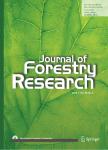Biogeographic divergence in leaf traits of Sapindus mukorossi and Sapindus delavayi and its relation to climate
到气候的 Sapindus mukorossi 和 Sapindus delavayi 和它的关系的叶特点地的 Biogeographic 分叉作者机构:Key Laboratory of Silviculture and Conservation of the Ministry of EducationCollege of ForestryBeijing Forestry UniversityBeijing 100083People’s Republic of China Yuanhua Forestry Biological Technology Co.Ltd.Sanming 650216FujianPeople’s Republic of China
出 版 物:《Journal of Forestry Research》 (林业研究(英文版))
年 卷 期:2021年第32卷第4期
页 面:1445-1456页
核心收录:
学科分类:0907[农学-林学] 08[工学] 0829[工学-林业工程] 09[农学]
主 题:Climate Leaf morphology Sapindus delavayi Sapindus mukorossi
摘 要:To explore differences in leaf morphology between Sapindus mukorossi and Sapindus delavayi,and how the environment might drive these differences,80 germplasm samples from the Sapindus germplasm nursery in Fujian Province were *** study revealed a wide variation and diversity in 16 germplasm traits,both within and between species grown under the same *** average,the relative contribution of intraspecific variability to total variability was more important(83%) than the relative contribution of interspecific variability(17%).PERMANOVA analysis showed differences in leaflet thickness,length,perimeter,length to width ratio,and leaf hairs or trichome *** analyses between leaf morphological traits and environmental variables indicated that leaves tended to be larger,longer,and thicker in wetter,warmer,and low-altitude *** analysis of the relationship between climate and leaf morphology revealed that *** had a greater sensitivity to climate variation,particularly in response to mean temperatures of the coldest and warmest seasons,which led to differences in leaf traits and the distribution of the two *** findings contribute to the understanding of leaf morphology variations in *** and ***,and provide a basis for the collection of Sapindus germplasm resources,their cultivation and use to help address climate change.



